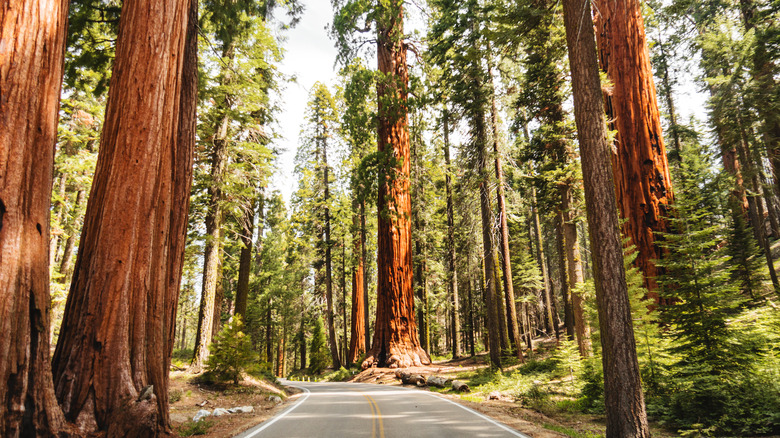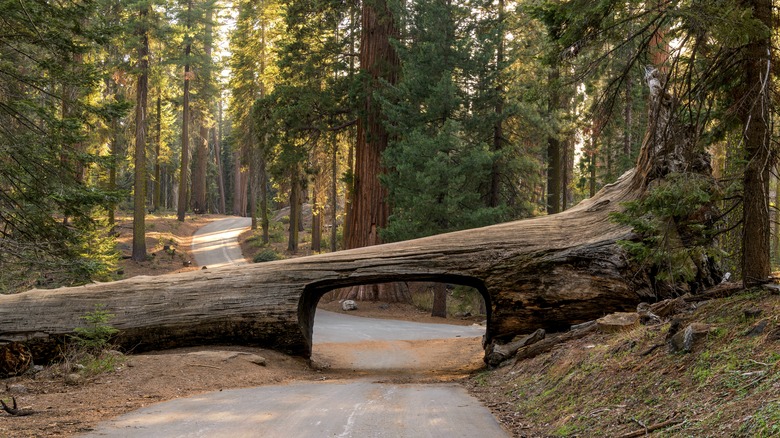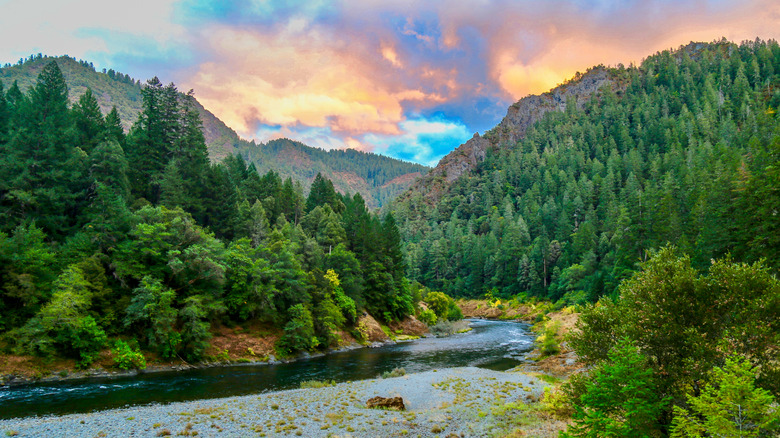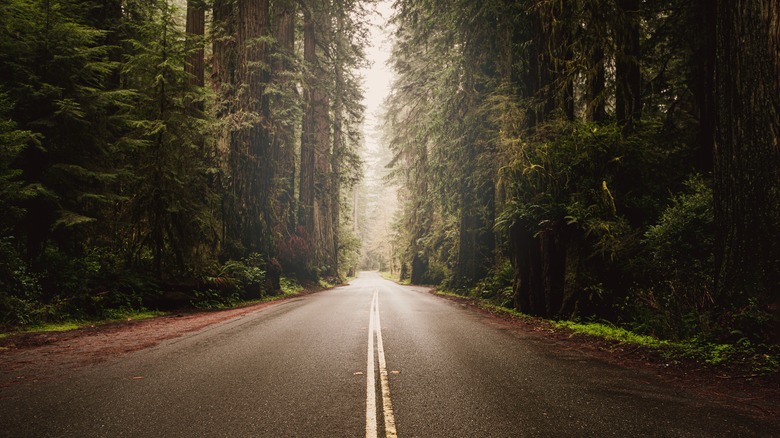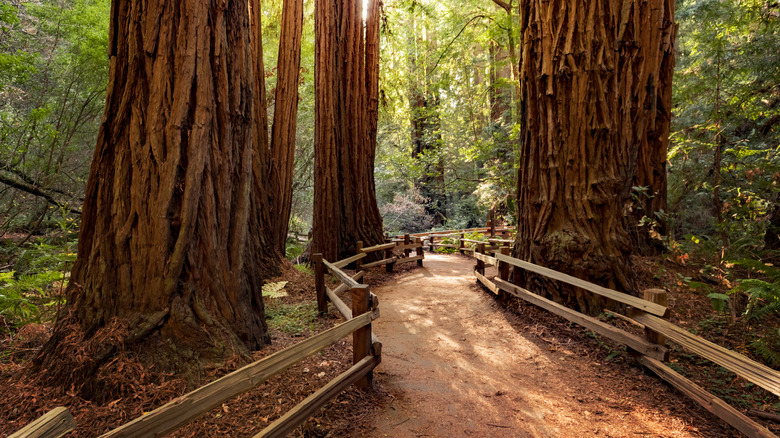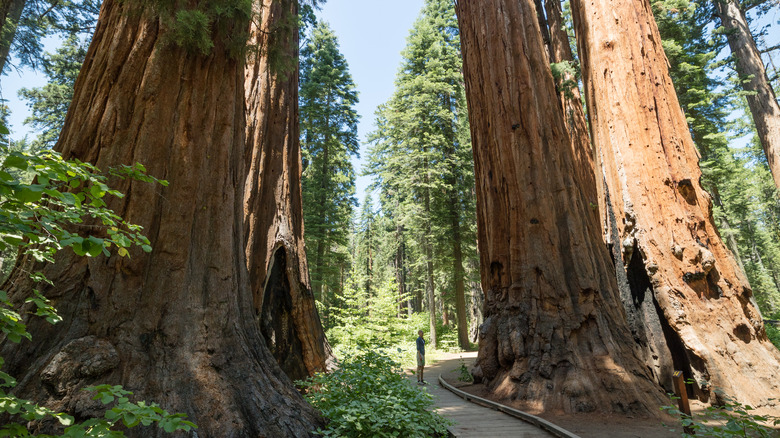The Best Destinations To Visit If You Want To See Huge Sequoia Trees
Sequoia trees are undoubtedly one of the most astounding living organisms on our planet. In the days of the Jurassic period, giant sequoia trees flourished throughout the Northern Hemisphere. Today, their species is limited to the western coastline of California and into the southern portion of Oregon. Found primarily in the moist foggy regions of the western slope of the Sierra Mountains, groves of sequoias scatter the coastlines and inland valleys for 260 miles. As some of the oldest trees on the planet, sequoias can live up to 3,500 years and never cease to continue growing — an encouragement to every one of us.
The trees are incredibly resilient, with thick bark that forms a protective barrier from harmful outside influences, including wildfires and wood-boring beetles. The source of this protective coat is a dense layer of tannins. Despite the devastation that wildfires can cause, flames are an asset to the growth of sequoias, clearing the land of competing organisms and nourishing the seedlings with lots of sunlight and nutrient-dense soil. Just as fire is a critical part of the maturation process for sequoias, the trees also require an immense amount of water. Rainfall and melted snow provide the adequate nourishment that's necessary for these giants to thrive on the Northwestern Coast. Some of the best places to view these sleeping giants up close range from Sequoia & Kings Canyon National Park in central California to Rogue River-Siskiyou National Forest, situated at the tip of Oregon's southern border.
Sequoia and Kings Canyon National Park
Located east of Fresno in central California, Sequoia and Kings Canyon National Park is nestled deep within the great West Coast wilderness. The grounds in this park are home to 40 giant sequoia groves whose trees have diameters up to 20 feet. The park consists of 631 square miles of protected forest and supports a thriving ecosystem of wildlife. Separated into several adjoining state and national parks, Grant Grove is a 90-acre plot with of some of the largest trees in Kings Canyon National Park. This particular cluster of sequoias is home to the General Grant Tree, which is celebrated as the nation's honorary Christmas tree every year! Sequoia and Kings Canyon National Park is a gem best explored on foot. Miles of hiking trails encircle the park, weaving visitors through fields of flowers, rushing rivers, and delicately carved valleys. Adjacent to Kings Canyon National Park is the Sequoia National Forest, which houses Giant Sequoia National Monument. This breathtaking forest houses the largest cluster of sequoia trees on the globe, spanning 328,315 acres. It's well worth the drive south to get a glimpse of this sleeping giant.
Rogue River-Siskiyou National Forest
Following Highway 101 across the California border into Oregon's craggy coastline, Rogue River-Siskiyou National Forest is a remote strip of untouched wilderness. Located 30 miles east of Brookings, Oregon, the Redwood Nature Trail in Southern Oregon guides visitors past some of the oldest living sequoias in the world, dating back 800 years. Nestled in one of the state's more remote regions, the park is typically quiet, adding to the breathtaking ambiance that permeates the park. The dramatic topography supports a diverse range of wildlife, including some of Oregon's only coastal sequoia trees. It's a breathtaking montage of flourishing fauna, fast-flowing streams, rustic footbridges, and lush undergrowth. The Redwood Nature Trail is a gorgeous 1.2-mile trail that snakes through lush undergrowth of huckleberries, ferns, mossy creek beds, and naturally occurring redwoods. While the trail might be short in length, it's a gateway into the forest's stunning canvas of mahogany and green.
Redwood National State Park
Located in Humboldt County, just 20 minutes outside Oregon territory, a canopy of high-rise sequoia trees plant their roots. As a World Heritage site, Redwood National State Park is the resting place of some of the world's tallest trees, led by Hyperion, the tallest sequoia tree in the world, standing at 380 feet tall — five stories taller than the Statue of Liberty! Towering canyons draped in emerald curtains of flora make way for wide open valleys overlooking the Pacific Ocean. While sequoias are certainly the star of the show in the Redwoods, they're not the only form of life worth mentioning. Roosevelt elk, as well as diverse aquatic life, like whales and seals, also reside in the park grounds.
Several groves are open for exploration throughout the Redwood, including Lady Bird Johnson Grove. Set atop the bluffs in Redwood National Park, it boasts extraordinary views of the surrounding terrain. The abundance of rain that rinses this habitat causes the trees in this grove to retain less of their traditional reddish hue. The loop trail in Lady Bird Johnson Grove is short and sweet, easily completed in 30 minutes. Make sure to bring your camera with you, as the trail features some of the most photogenic hot spots in the entire park!
Muir Woods National Park
Stretching from the border shared between California and Oregon all the way to Big Sur, the coastal redwoods in Muir Woods National Park are part of a coveted wilderness sanctuary. Just 45 minutes from San Francisco in Marin County, this California national park is part of a large network of forested grounds within Golden Gate National Park. Muir Woods has a rich cultural and colonial heritage steeped in the history of the indigenous Coast Miwok, who were some of the earliest inhabitants of the land.
The redwoods in this forest are not only an extravagant visual, but they also play an essential role in the land's natural nutrient and carbon cycle. Coastal redwoods in Muir Woods can easily reach 800 years old, with the oldest living sequoia recorded at 1,200 years old! The average lifespan of these delicate living fossils categorizes Muir Woods as an old-growth forest, a testament to its inhabitants' resilience.
Calaveras Big Trees State Park
Two hours east of Sacramento, Calaveras Big Trees State Park houses two giant groves of sequoia trees. As the homeland of Discovery Tree, the first sequoia discovery that was widely publicized in 1852, Calaveras is a sacred wilderness range in the history of sequoias. Sadly, the giant sequoia was cut down in 1853 by a local resident hoping to display the tree for public exhibition. The trees in this state park are known to reach incredible heights, testing the boundary between earth and sky. The largest living tree in Calaveras is the Louis Agassiz tree, located in the southern grove of the park. This sleeping giant was measured at 250 feet tall. Several of the trees have a diameter so wide that the roads are paved right through the center, creating an unparalleled photo op! With miles of hiking trails and several campsites, it's a great weekend getaway for some fresh air and a restful time in nature.
